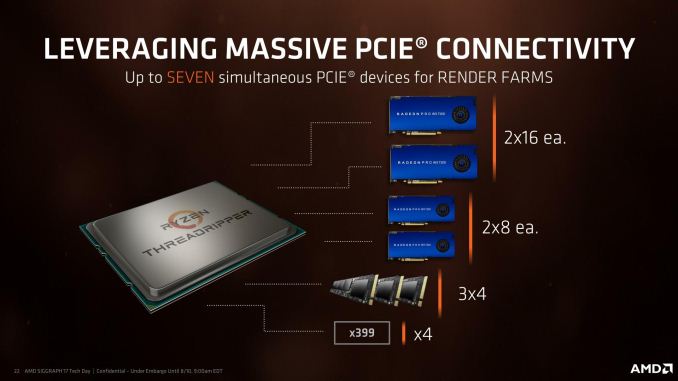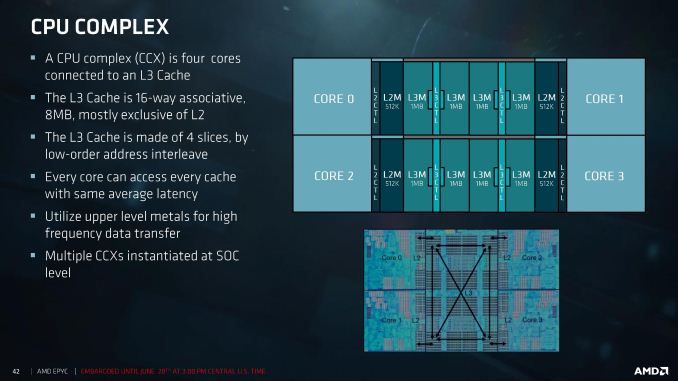The AMD Ryzen Threadripper 1950X and 1920X Review: CPUs on Steroids
by Ian Cutress on August 10, 2017 9:00 AM ESTFeeding the Beast
When frequency was all that mattered for CPUs, the main problem became efficiency, thermal performance, and yields: the higher the frequency was pushed, the more voltage needed, the further outside the peak efficiency window the CPU was, and the more power it consumed per unit work. For the CPU that was to sit at the top of the product stack as the performance halo part, it didn’t particularly matter – until the chip hit 90C+ on a regular basis.
Now with the Core Wars, the challenges are different. When there was only one core, making data available to that core through caches and DRAM was a relatively easy task. With 6, 8, 10, 12 and 16 cores, a major bottleneck suddenly becomes the ability to make sure each core has enough data to work continuously, rather than waiting at idle for data to get through. This is not an easy task: each processor now needs a fast way of communicating to each other core, and to the main memory. This is known within the industry as feeding the beast.
Top Trumps: 60 PCIe Lanes vs 44 PCIe lanes
After playing the underdog for so long, AMD has been pushing the specifications of its new processors as one of the big selling points (among others). Whereas Ryzen 7 only had 16 PCIe lanes, competing in part against CPUs from Intel that had 28/44 PCIe lanes, Threadripper will have access to 60 lanes for PCIe add-in cards. In some places this might be referred to as 64 lanes, however four of those lanes are reserved for the X399 chipset. At $799 and $999, this competes against the 44 PCIe lanes on Intel’s Core i9-7900X at $999.
The goal of having so many PCIe lanes is to support the sort of market these processors are addressing: high-performance prosumers. These are users that run multiple GPUs, multiple PCIe storage devices, need high-end networking, high-end storage, and as many other features as you can fit through PCIe. The end result is that we are likely to see motherboards earmark 32 or 48 of these lanes for PCIe slots (x16/x16, x8/x8/x8/x8, x16/x16/x16, x16/x8/x16/x8), followed by a two or three for PCIe 3.0 x4 storage via U.2 drives or M.2 drives, then faster Ethernet (5 Gbit, 10 Gbit). AMD allows each of the PCIe root complexes on the CPU, which are x16 each, to be bifurcated down to x1 as needed, for a maximum of 7 devices. The 4 PCIe lanes going to the chipset will also support several PCIe 3.0 and PCIe 2.0 lanes for SATA or USB controllers.
Intel’s strategy is different, allowing 44 lanes into x16/x16/x8 (40 lanes) or x16/x8/x16/x8 (40 lanes) or x16/x16 to x8/x8/x8x8 (32 lanes) with 4-12 lanes left over for PCIe storage or faster Ethernet controllers or Thunderbolt 3. The Skylake-X chipset then has an additional 24 PCIe lanes for SATA controllers, gigabit Ethernet controllers, SATA controllers and USB controllers.
Top Trumps: DRAM and ECC
One of Intel’s common product segmentations is that if a customer wants a high core count processor with ECC memory, they have to buy a Xeon. Typically Xeons will support a fixed memory speed depending on the number of channels populated (1 DIMM per channel at DDR4-2666, 2 DIMMs per channel at DDR4-2400), as well as ECC and RDIMM technologies. However, the consumer HEDT platforms for Broadwell-E and Skylake-X will not support these and use UDIMM Non-ECC only.
AMD is supporting ECC on their Threadripper processors, giving customers sixteen cores with ECC. However, these have to be UDIMMs only, but do support DRAM overclocking in order to boost the speed of the internal Infinity Fabric. AMD has officially stated that the Threadripper CPUs can support up to 1 TB of DRAM, although on close inspection it requires 128GB UDIMMs, which max out at 16GB currently. Intel currently lists a 128GB limit for Skylake-X, based on 16GB UDIMMs.
Both processors run quad-channel memory at DDR4-2666 (1DPC) and DDR4-2400 (2DPC).
Top Trumps: Cache
Both AMD and Intel use private L2 caches for each core, then have a victim L3 cache before leading to main memory. A victim cache is a cache that obtains data when it is evicted from the cache underneath it, and cannot pre-fetch data. But the size of those caches and how AMD/Intel has the cores interact with them is different.
AMD uses 512 KB of L2 cache per core, leading to an 8 MB of L3 victim cache per core complex of four cores. In a 16-core Threadripper, there are four core complexes, leading to a total of 32 MB of L3 cache, however each core can only access the data found in its local L3. In order to access the L3 of a different complex, this requires additional time and snooping. As a result there can be different latencies based on where the data is in other L3 caches compared to a local cache.
Intel’s Skylake-X uses 1MB of L2 cache per core, leading to a higher hit-rate in the L2, and uses 1.375MB of L3 victim cache per core. This L3 cache has associated tags and the mesh topology used to communicate between the cores means that like AMD there is still time and latency associated with snooping other caches, however the latency is somewhat homogenized by the design. Nonetheless, this is different to the Broadwell-E cache structure, that had 256 KB of L2 and 2.5 MB of L3 per core, both inclusive caches.












347 Comments
View All Comments
bigboxes - Friday, August 11, 2017 - link
You're acting just like the fanboi trolls you claim to loathe.Alexvrb - Sunday, August 13, 2017 - link
Yeah that was definitely a pot<->kettle comment. LOL.trivor - Saturday, August 12, 2017 - link
For those of you considering this CPU the fact is you are going to get MUCH better value by choosing one of the Ryzen CPUs - Ryzen 7 1800X is now at around $420 for 8/16 and the 7 1700 (8/16 again) has been on sale for as little as $299. Now, if you need the high thread counts for work on things like content creation and you still want to be able to run games it will be competitive (read: not the king of the hill) when you are running your games. So, if you do more than 50% of your computing time is gaming then go for an Intel CPU OR one of the Ryzen 5/7 consumer CPUs.Lord of the Bored - Friday, August 11, 2017 - link
Which would explain why the introduction doesn't mention the Netburst fiasco by name."The company that could force the most cycles through a processor could get a base performance advantage over the other, and it led to some rather hot chips, with the certain architectures being dropped for something that scaled better. " is, to my eye, actually attention-grabbing in the way it avoids using any names like Preshott, I mean Prescott and only obliquely references the 1GHz Athlon, the Thunderbirds, Sledgehammer, and the whole Netburst fiasco that destroyed the once-respected Pentium name.
But no, let's just say that "certain architectures" were dropped and there were "some rather hot chips" and keep Intel happy. They need that bone right now, though not as much as they did during the reign of Thunderbird and the 'hammers.
Hurr Durr - Friday, August 11, 2017 - link
If the unword "NetBurst" triggers you so much, it`s not processors you should spend money on, but shrinks.Lord of the Bored - Friday, August 11, 2017 - link
Hey, we were an Athlon house. I didn't suffer through the series of mis-steps that plagued Intel. I just thought the sentence was conspicuous in how hard it tried to not name names.mlambert890 - Saturday, August 12, 2017 - link
"name names"? There are 2 companies that make CPUs. Everyone knows Netburst was Intel P4 era. It's not Watergate ok?Conspiracy obsession has become a legitimate mental illness.
fallaha56 - Thursday, August 10, 2017 - link
handy not to show the new Intel chip struggle eh?Breit - Friday, August 11, 2017 - link
Is it possibly to bench the Intel CPUs (especially the i9-7900x) for those latency/single-thread tests with Hyperthreading turned off? This would probably give a better comparison to AMDs Game Mode and hopefully higher numbers too due to double the cache/registers available to one thread.cheshirster - Friday, August 11, 2017 - link
Skylake-X sucks at gaming.7800X is slower than 1600X.